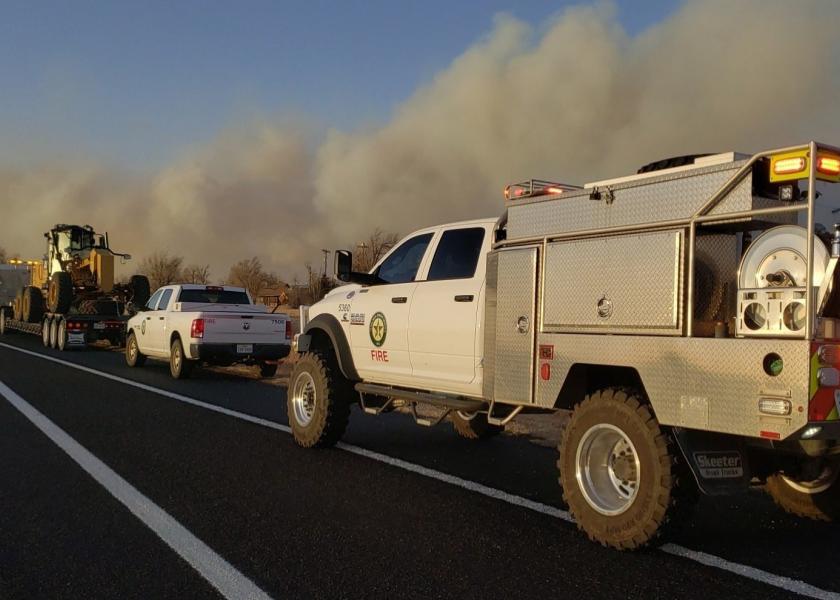Critical Fire Weather Predicted in Texas Through Dec. 26

Critical fire weather is forecast through Dec. 26 for portions of North and West Texas, with Dec. 24 holding the most potential for wildfire activity, particularly in the Panhandle.
The Texas A&M Forest Service has prepositioned resources across the area, including three single-engine air tankers and an air attack platform in Childress, and two large air tankers and an aerial supervision module in Abilene to support suppression efforts as requested.
“Wildfire potential increases through the weekend as strong winds, above normal temperatures and low humidity align with dry fuels,” said Brad Smith, Texas A&M Forest Service Predictive Services department head. “The footprint of critically dry fuels will continue to expand south and east as we experience above normal temperatures and little rainfall.”
Be cautious with fire activities
The Texas A&M Forest Service urges Texans to be cautious when participating in activities that may cause a spark this holiday season. Ninety percent of wildfires in Texas are human-caused, and during the winter holiday season, debris burning and equipment use make up 68% of all wildfires.
“These starts include brush pile burning, burning leaves, unsafe burning of household trash, loose trailer chains, welding and more,” said Karen Stafford, Texas A&M Forest Service Prevention Program coordinator. “We urge Texans to be mindful of any outdoor activity that may cause a spark this holiday.”
To check for local burn bans, visit https://tfsweb.tamu.edu/burnbans/.
Holiday debris burning and recycling
In Texas, careless debris burning causes the largest number of human-caused wildfires. For example, unsafe burning of wrapping paper, gift boxes and Christmas trees after the holidays could spark outdoor fires.
When burning debris, always check with local officials first. Burn responsibly by keeping your burn pile small, locating the pile at least 150 feet away from buildings, having a water source within reach in case the fire escapes and staying with your fire until it is completely out.
Recycling can serve as an alternative to debris burning.
“For wrapping paper, the ‘scrunch’ test is an easy way to tell if the paper is recyclable or not,” said Stafford. “If you scrunch a piece of paper into a ball in your hand and the paper stays in a ball, it can be recycled.”
Only plain wrapping paper can be recycled, meaning no metallic, glitter or textured paper, nor can tape, ribbons or bows.
Real Christmas trees are also recyclable and renewable. Check with your local waste management company, a nearby garden center or a local conservation organization to find out if Christmas tree recycling is available in your area. Trees can also be mulched and even put into ponds to create fish habitats.
Travel safety
A significant number of wildfires are started by equipment, including vehicles, each year. If you have plans to travel this holiday season, take the time to inspect your vehicle before you take to the highways.
Underinflated and failing tires are a significant wildfire hazard as wheel rims may produce sparks when they contact the pavement. Ensure your tires have been checked for air pressure and any holes before traveling.
Avoid driving and parking in tall, dry grass as the underside of your vehicle may start wildfires if exposed to dry vegetation.
Dragging chains may also create a spark. Secure trailer safety chains to ensure they will not contact the road.
Fireworks safety
When using fireworks during the holidays, don’t let your fun turn into flames. Fireworks should always be used outdoors on flat, smooth surfaces and away from dry grass and flammable materials. Check for local restrictions on fireworks and burn bans before use. Always have a water source nearby and call 9-1-1 immediately if a fire starts.
Fire safety outdoors
Campfires can be a great source of warmth and fuel for cooking but keep safety in mind when starting one. Locate a safe spot for your campfire, away from anything flammable and far from overhead hazards. Pile up rocks around your fire to help keep the wind out and fire embers in. When you are done with your campfire, fully extinguish it. Drown, stir and feel the area for heat. Hold your hand just above the wet ashes — if you feel any residual heat, continue to add water and stir. If it is too hot to touch, it is too hot to leave.
If a wildfire is spotted, immediately contact local authorities. A quick response can help save lives and property.
For more information on wildfire prevention, visit https://tfsweb.tamu.edu/winterwildfireprevention/.







